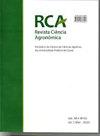鹰嘴豆试验的最佳小区面积和重复数
IF 0.7
4区 农林科学
Q3 AGRICULTURE, MULTIDISCIPLINARY
引用次数: 0
摘要
本文章由计算机程序翻译,如有差异,请以英文原文为准。
Optimum plot size and number of replications for experiments with the chickpea
- In agricultural experimentation, use of the optimum plot size is an important way of increasing experimental precision; however, studies of this type are scarce for the chickpea, a legume that has been conquering both the market and consumers throughout the world. The aim of this study, therefore, was to determine the optimum plot size for evaluating experiments with the chickpea, in scenarios comprising combinations of the number of treatments, number of replications and levels of precision. Two blank experiments were carried out, comprising eight crop rows, 7 m in length, at a spacing of 50 cm between rows and 10 cm between plants; the six central rows were evaluated, giving a total of 60 plants per row. The index of soil heterogeneity was determined, and the optimum plot size was estimated using the Hatheway method in scenarios formed by a combination of i treatments (i = 4, 8, 12 and 16), r replications (r = 3, 4, 5, 6, 7 and 8) and levels of precision (LSD = 25%, 30% and 40%). The index of soil heterogeneity was greater than 0.7 for each of the variables under evaluation. The Hatheway method makes it possible to estimate different plot sizes based on the conditions and limitations of the experimental area. In exper iments with the chickpea including 4 to 16 treatments, 25% LSD and six replications, plots of 25 basic units are suf fi cient to identify signi fi cant differences between the mean values of the treatments with a probability of 5%
求助全文
通过发布文献求助,成功后即可免费获取论文全文。
去求助
来源期刊

Revista Ciencia Agronomica
Agricultural and Biological Sciences-Horticulture
CiteScore
2.00
自引率
0.00%
发文量
41
审稿时长
4-8 weeks
期刊介绍:
To publish technical-scientific articles and study cases (original projects) that are not submitted to other journals, involving new researches and technologies in fields related to Agrarian Sciences. Articles concerning routine analysis, preliminary studies, technical notes and those which merely report laboratorial analysis employing traditional methodology will not be accepted for publication. The Journal of Agronomical Science also has the mission to promote the exchange of experience in the referred fields.
 求助内容:
求助内容: 应助结果提醒方式:
应助结果提醒方式:


